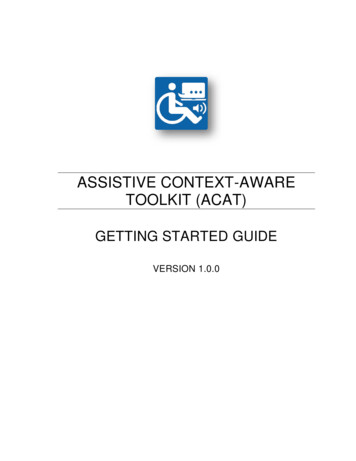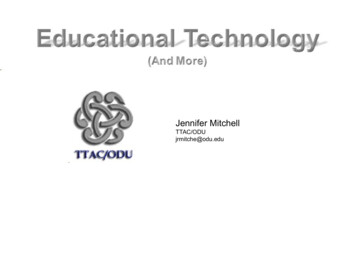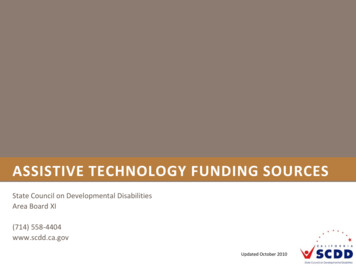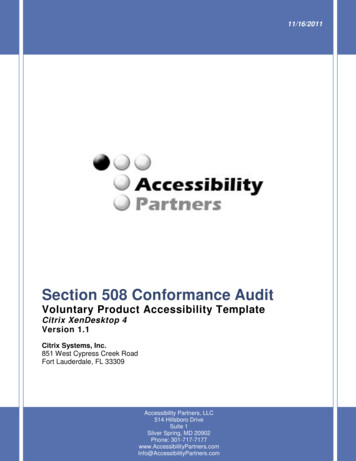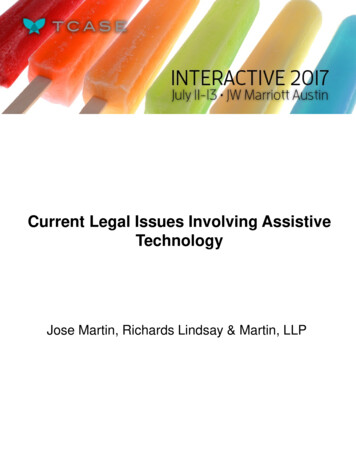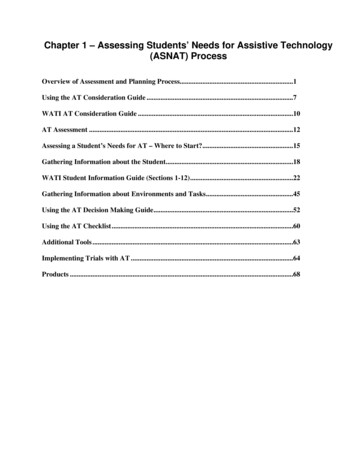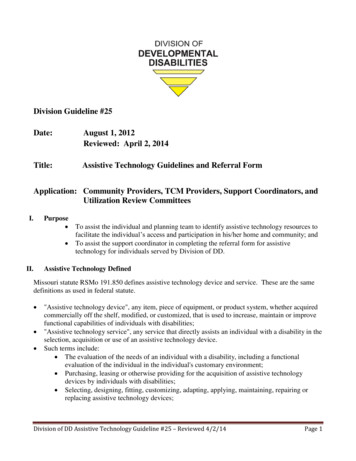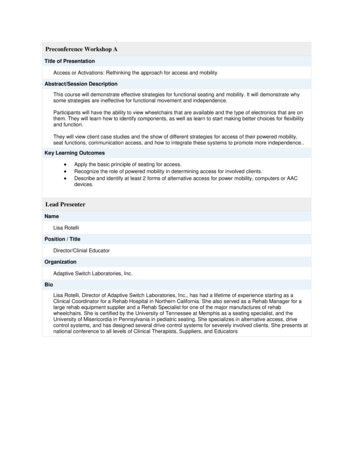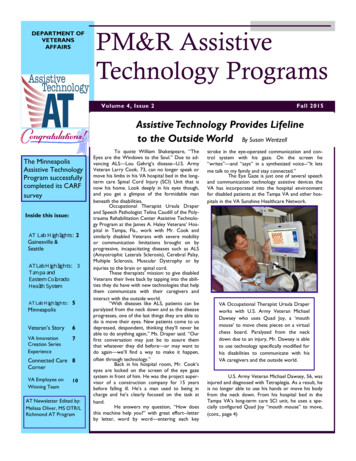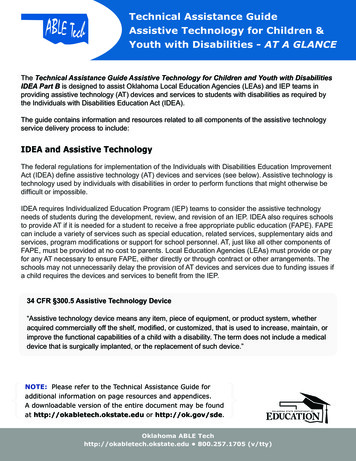
Transcription
Technical Assistance GuideAssistive Technology for Children &Youth with Disabilities - AT A GLANCEThe Technical Assistance Guide Assistive Technology for Children and Youth with DisabilitiesIDEA Part B is designed to assist Oklahoma Local Education Agencies (LEAs) and IEP teams inproviding assistive technology (AT) devices and services to students with disabilities as required bythe Individuals with Disabilities Education Act (IDEA).The guide contains information and resources related to all components of the assistive technologyservice delivery process to include:IDEA and Assistive TechnologyThe federal regulations for implementation of the Individuals with Disabilities Education ImprovementAct (IDEA) define assistive technology (AT) devices and services (see below). Assistive technology istechnology used by individuals with disabilities in order to perform functions that might otherwise bedifficult or impossible.IDEA requires Individualized Education Program (IEP) teams to consider the assistive technologyneeds of students during the development, review, and revision of an IEP. IDEA also requires schoolsto provide AT if it is needed for a student to receive a free appropriate public education (FAPE). FAPEcan include a variety of services such as special education, related services, supplementary aids andservices, program modifications or support for school personnel. AT, just like all other components ofFAPE, must be provided at no cost to parents. Local Education Agencies (LEAs) must provide or payfor any AT necessary to ensure FAPE, either directly or through contract or other arrangements. Theschools may not unnecessarily delay the provision of AT devices and services due to funding issues ifa child requires the devices and services to benefit from the IEP.34 CFR §300.5 Assistive Technology Device“Assistive technology device means any item, piece of equipment, or product system, whetheracquired commercially off the shelf, modified, or customized, that is used to increase, maintain, orimprove the functional capabilities of a child with a disability. The term does not include a medicaldevice that is surgically implanted, or the replacement of such device.”{ }NOTE: Please refer to the Technical Assistance Guide foradditional information on page resources and appendices.A downloadable version of the entire document may be foundat http://okabletech.okstate.edu or http://ok.gov/sde.Oklahoma ABLE Techhttp://okabletech.okstate.edu 800.257.1705 (v/tty)
Technical Assistance Guide Assistive Technology forChildren & Youth with Disabilities - at a glancePage 234 CFR §300.6 Assistive Technology Service“Assistive technology service means any service that directly assists a child with a disabilityin the selection, acquisition, or use of an assistive technology device. The term includes:(a) The evaluation of the needs of a child with a disability, including a functional evaluationof the child in the child’s customary environment;(b) Purchasing, leasing, or otherwise providing for the acquisition of assistive technologydevices by children with disabilities;(c) Selecting, designing, fitting, customizing, adapting, applying, maintaining, repairing,or replacing assistive technology devices;(d) Coordinating and using other therapies, interventions, or services with assistive technologydevices, such as those associated with existing education and rehabilitation plans and programs;(e) Training or technical assistance for a child with a disability or, if appropriate, that child’s family;and,(f) Training or technical assistance for professionals (including individuals providing educationor rehabilitation services), employers, or other individuals who provide services to, employ, orare otherwise substantially involved in the major life functions of that child.”Quality Indicators for Assistive TechnologyWhen determining the assistive technology needs of a student with a disability, it is important forLEA teams to provide high-quality, assistive technology services. The Quality Indicators for AssistiveTechnology (QIAT) were developed by focus groups, validated through research, and provide a set ofdescriptors that can serve as a guideline for LEAs to evaluate the quality of their AT services. Theseindicators are broken down into eight areas that are important to the development and delivery ofassistive technology services and include:(1) Consideration of AT Needs(5) Evaluation of Effectiveness of AT(2) Assessment of AT Needs(6) AT in Transition(3) AT in the IEP(7) Administrative Support for AT(4) AT Implementation (8) AT Professional DevelopmentA set of self-assessment matrices have been developed as a companion piece to the QualityIndicators intent statements for each area. In most instances the Quality Indicators are alsoappropriate for the consideration of AT for students who qualify for services under other legislation(e.g. Section 504 of the Rehabilitation Act, Americans with Disabilities Act).Visit http://qiat.org for more information.Oklahoma ABLE Techhttp://okabletech.okstate.edu 800.257.1705 (v/tty)
Technical Assistance Guide Assistive Technology forChildren & Youth with Disabilities - at a glancePage 3Consideration of AT NeedsThe following is a flowchart that may be used to guide IEP teams in checking “Yes” or “No” on the IEPregarding whether or not a child requires AT devices and services:AT Consideration QuestionsThe following questions may help the IEP team through the process of reaching a “Yes” or “No”answer to the question: “Whether the child needs assistive technology devices and services.” Are there concerns about the student’s ability to complete educational tasks as indicatedin the IEP? Are there educational tasks that the student is not being asked to attempt because of his/herdisability in which assistive technology may be helpful? For example; Because the studenthas a reading disability and reads 2 levels below their actual grade, thestudent has modifications to shorten reading assignments. Is thereassistive technology that could allow the student to access completereading assignments?Oklahoma ABLE Techhttp://okabletech.okstate.edu 800.257.1705 (v/tty)
Technical Assistance Guide Assistive Technology forChildren & Youth with Disabilities - at a glancePage 4AT Consideration Questions Continued. What educational tasks do we expect the student to complete that he/she isn’t able to dobecause of his/her disability? What strategies, modifications, accommodations, or assistive technologies have been tried inthe past or are currently in use to help the student complete educational tasks?o Are any of them working?o Are there things that worked in the past that need to be reconsidered?o Are there things that have not been tried that need to be introduced? Does the student need assistive technology to access instructional materials (e.g., textbooks,worksheets) and/or to access general technology used by other students (e.g., computers inthe computer lab)?Visit http://joyzabala.com and http://okabletech.okstate.edu for more information.Assessment of AT NeedsThe following are important to note as teams are completing the assessment process: Unlike other educational assessments, an assistive technology assessment is not completedwith the administration of one test during a singular event. Assistive technology assessment is ongoing and should be a continual part of the student’seducational planning. Assistive technology assessments are conducted within the student’s customary educationalsetting by a multidisciplinary team knowledgeable about assistive technology devices andservices. The QIAT Assessment of AT Needs document provides additional information to guide the IEPteam through this process.The following is a flowchart for the AT Assessment Process and provides guiding information andresources for each step of the process.Oklahoma ABLE Techhttp://okabletech.okstate.edu 800.257.1705 (v/tty)
Technical Assistance Guide Assistive Technology forChildren & Youth with Disabilities - at a glanceOklahoma ABLE Techhttp://okabletech.okstate.edu 800.257.1705 (v/tty)Page 5
Technical Assistance Guide Assistive Technology forChildren & Youth with Disabilities - at a glancePage 6AT Assessment is a process driven by identifying specific needs of the individual and matching an ATdevice and/or service to help that individual complete a task. AT assessment is not standardized, butshould: Be systematic - LEAs have identified a systematic approach that everyone follows. Be replicable - LEAs should document the AT assessment process and tools used to conductindividual student assessments. This not only provides a roadmap of how the IEP team arrivedat its AT assessment decision but allows another IEP team to replicate the results if needed. Provide accountability - LEAs will want proof that a piece of AT works before following throughwith funding. Be performed by a team familiar with AT populations and issues - LEAs need to ensure that LEAteam members are knowledgeable to make decisions by receiving the appropriate training.Visit www.joyzabala.com for more information.AT in the school settingis a process and can bestarted at any point on thestudent’s educational path.Oklahoma ABLE Techhttp://okabletech.okstate.edu 800.257.1705 (v/tty)
Technical Assistance Guide Assistive Technology forChildren & Youth with Disabilities - at a glancePage 7Assistive Technology for TransitionAssistive technology can play an integral role in both the early childhood and post-high schooltransition processes. If it is determined that the AT used in early-intervention and or high schoolshould transition with the youth, the entities involved (i.e. family, LEA,DRS, etc.) need to sign anAgreement for the Purchase/Sale or Statement Declining the Sale of AT Devices. See the TechnicalAssistance Guide for this form as well as additional information.Related Issues in IDEA 2004Universal Design for Learning (UDL) is a set of principles for designing curriculum that providesall individuals, including those with learning differences, equal opportunities to learn.Visit http://cast.org for additional information.Accessible Instructional Materials (AIM) are materials that are designed or converted in a waythat makes them usable across the widest range of student variability regardless of format (print,digital, graphic, audio, video). Students with vision impairments, physical disabilities, and/or printdisabilities may need AIM in order to receive FAPE. Assistive Technology may be used and/orrequired to access AIM.Visit http://cast.org and http://okabletech.okstate.edu for more information.Oklahoma ABLE Techhttp://okabletech.okstate.edu 800.257.1705 (v/tty)
Technical Assistance Guide Assistive Technology forChildren & Youth with Disabilities - at a glancePage 8AT Resources in OklahomaOklahoma ABLE TechOklahoma State Department of EducationState AT Act Program that provides short-termequipment loans, demonstrations, training, andinformation and referral on assistive technology,as well as assistance obtaining accessibleinstructional materials (AIM), NIMAS files, andAIM-related technologyContracts with Oklahoma ABLE Tech to providean Assistive Technology and InformationServices Program for Oklahoma schoolsPhone: 800.257.1705Web: http://okabletech.okstate.eduLiberty BrailleAIM Center at OLBPHLocated at the Oklahoma Library for the Blindand Physically Handicapped, the AIM Centerprovides AT as it relates to reading books inaccessible digital and audio formatsPhone: 800.523.0288 or 405.521.3514Web: www.library.state.ok.us/aimPhone: 405.522.3248Web: http://ok.gov/sdeProvides no-cost school term loans of textbooksin accessible formats such as large print, braille,and digital on iPad, to print-disabled studentsserved under an IEP/ISPPhone: 800.920.3369 or 405.562.3996Web: http://libertybraille.comSpecial Education Resolution Center (SERC)Manages the special education due processhearing system and mediation for the State ofOklahomaPhone: 918.270.1849 or 888.267.0028Web: http://serc.okstate.eduPrintablesThe AT Technical Assistance Guide contains printables on: The Quality Indicators for AT that can be used to assist teams with self-evaluation of AT servicedelivery within districts. Visit http://qiat.org for more information. Consideration and Assessment that can be used when going through the AT consideration andassessment processes. Visit http://joyzabala.com and http://okabletech.okstate.edu formore information. The purchase and sale of AT that can be used when transitioning AT from one entity to another(i.e. high school to family ownership). See the Technical Assistance Guide for this form. How to determine the value of used AT when transitioningownership to another entity. See the Technical AssistanceGuide for this form.Oklahoma ABLE Techhttp://okabletech.okstate.edu 800.257.1705 (v/tty)
"Assistive technology service means any service that directly assists a child with a disability . in the selection, acquisition, or use of an assistive technology device. The term includes: (a) The evaluation of the needs of a child with a disability, including a functional evaluation . of the child in the child's customary environment;
